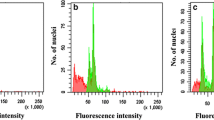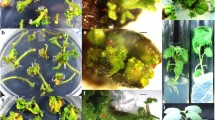Abstract
Maesa perlarius is a medicinal plant that produces maesabalides, which possess selective and strong anti-leishmania activity. In this study, M. perlarius plants were regenerated from leaf-derived calli. Shoots were induced in Murashige and Skoog medium in the presence of thidiazuron in combination with α-naphthalene acetic acid. In contrast to seed-derived plants, callus-derived regenerants were tetraploid showing typical characteristics of higher ploidy phenotypes. We assessed the impact of indirect plant regeneration and associated increase in ploidy on the production of saponin by means of LC–MS analysis. Tetraploid M. perlarius produce a saponin profile, which was not significantly different from seed grown plants. Based on this study, we concluded that saponin production in M. perlarius is not qualitatively changed by a genome-doubling event.






Similar content being viewed by others
References
Aina O, Quesenberry K, Gallo M (2012) In vitro induction of tetraploids in Arachis paraguariensis. Plant Cell Tissue Organ Cult 111:231–238
Apers S, De Bruyne TE, Claeys M, Vlietinck AJ, Pieters LAC (1999) New acylated triterpenoid saponins from Maesa lanceolata. Phytochemistry 52:1121–1131
Baiza AM, Quiroz A, Ruiz JA, Maldonado-Mendoza I, Loyola-Vargas VM (1998) Growth patterns and alkaloid accumulation in hairy root and untransformed root cultures of Datura stramonium. Plant Cell Tissue Organ Cult 54:123–130
Banthorpe DV, Branch SA, Njar VCO, Osborne MG, Watson DG (1986) Ability of plant callus cultures to synthesize and accumulate lower terpenoids. Phytochemistry 25:629–636
Baskaran P, Jayabalan N, Van Staden J (2011) Production of psoralen by in vitro regenerated plants from callus cultures of Psoralea corylifolia L. Plant Growth Regul 65:47–54
Bonfill M, Mangas S, Moyano E, Cusido R, Palazón J (2011) Production of centellosides and phytosterols in cell suspension cultures of Centella asiatica. Plant Cell Tissue Organ Cult 104:61–67
Bourgaud F, Gravot A, Milesi S, Gontier E (2001) Production of plant secondary metabolites: a historical perspective. Plant Sci 161:839–851
Caruso I, Lepore L, De Tommasi N, Dal Piaz F, Frusciante L, Aversano R, Garramone R, Carputo D (2011) Secondary metabolite profile in induced tetraploids of wild Solanum commersonii Dun. Chem Biodivers 8:2226–2237
Collin HA (2001) Secondary product formation in plant tissue cultures. Plant Growth Regul 34:119–134
De Jesus-Gonzalez L, Weathers PJ (2003) Tetraploid Artemisia annua hairy roots produce more artemisinin than diploids. Plant Cell Rep 21:809–813
Dehghan E, Häkkinen S, Oksman-Caldentey K-M, SAhmadi F (2012) Production of tropane alkaloids in diploid and tetraploid plants and in vitro hairy root cultures of Egyptian henbane (Hyoscyamus muticus L.). Plant Cell Tissue Organ Cult 110:35–44
Dhawan OP, Lavania UC (1996) Enhancing the productivity of secondary metabolites via induced polyploidy: a review. Euphytica 87:81–89
Faizal A, Lambert E, Foubert K, Apers S, Geelen D (2011) In vitro propagation of four saponin producing Maesa species. Plant Cell Tissue Organ Cult 106:215–223
Foubert K, Vermeersch M, Theunis M, Apers S, Cos P, Claeys M, Van Puyvelde L, Pieters L, Maes L (2009) LC-MS analysis of 13,28-epoxy-oleanane saponins in Maesa spp. extracts with antileishmanial activity. Phytochem Anal 20:159–167
Galbraith DW, Harkins KR, Maddox JM, Ayres NM, Sharma DP, Firoozabady E (1983) Rapid flow cytometric analysis of the cell-cycle in intact plant-tissues. Science 220:1049–1051
Germonprez N, Puyvelde LV, Maes L, Tri MV, Kimpe ND (2004) New pentacyclic triterpene saponins with strong anti-leishmanial activity from the leaves of Maesa balansae. Tetrahedron 60:219–228
Grover A, Yadav J, Biswas R, Pavan C, Mishra P, Bisaria V, Sundar D (2012) Production of monoterpenoids and aroma compounds from cell suspension cultures of Camellia sinensis. Plant Cell Tissue Organ Cult 108:323–331
Hayashi H, Huang P, Takada S, Obinata M, Inoue K, Shibuya M, Ebizuka Y (2004) Differential expression of three oxidosqualene cyclase mRNAs in Glycyrrhiza glabra. Biol Pharm Bull 27:1086–1092
Kaensaksiri T, Soontornchainaksaeng P, Soonthornchareonnon N, Prathanturarug S (2011) In vitro induction of polyploidy in Centella asiatica (L.) Urban. Plant Cell Tissue Organ Cult 107:187–194
Lavania UC (2005) Genomic and ploidy manipulation for enhanced production of phyto-pharmaceuticals. Plant Genet Resour 3:170–177
Lavania UC, Srivastava S, Lavania S, Basu S, Misra NK, Mukai Y (2012) Autopolyploidy differentially influences body size in plants, but facilitates enhanced accumulation of secondary metabolites, causing increased cytosine methylation. Plant J 71:539–549
Levy M (1976) Altered glycoflavone expression in induced autotetraploids of Phlox drummondii. Biochem Syst Ecol 4:249–254
Lopez CMR, Wetten AC, Wilkinson MJ (2010) Progressive erosion of genetic and epigenetic variation in callus-derived cocoa (Theobroma cacao) plants. New Phytol 186:856–868
Loureiro J, Rodriguez E, Dolezel J, Santos C (2006) Comparison of four nuclear isolation buffers for plant DNA flow cytometry. Ann Bot Lond 98:679–689
Malik S, Cusidó RM, Mirjalili MH, Moyano E, Palazón J, Bonfill M (2011) Production of the anticancer drug taxol in Taxus baccata suspension cultures: a review. Process Biochem 46:23–34
Miguel C, Marum L (2011) An epigenetic view of plant cells cultured in vitro: somaclonal variation and beyond. J Exp Bot 62:3713–3725
Mohanty S, Panda MK, Subudhi E, Nayak S (2008) Plant regeneration from callus culture of Curcuma aromatica and in vitro detection of somaclonal variation through cytophotometric analysis. Biol Plantarum 52:783–786
Murashige T, Skoog F (1962) A revised medium for rapid growth and bio assays with tobacco tissue cultures. Physiol Plant 15:473–497
Phillips R, Kaeppler S, Olhoft P (1994) Genetic instability of plant tissue cultures: breakdown of normal controls. Proc Natl Acad Sci USA 91:5222–5226
Pinol MT, Palazon J, Cusido RM, Ribo M (1999) Influence of calcium ion concentration in the medium on tropane alkaloid accumulation in Datura stramonium hairy roots. Plant Sci 141:41–49
Riddle N, Jiang H, An L, Doerge R, Birchler J (2010) Gene expression analysis at the intersection of ploidy and hybridity in maize. Theor Appl Genet 120:341–353
Rout GR, Samantaray S, Das P (2000) In vitro manipulation and propagation of medicinal plants. Biotechnol Adv 18:91–120
Shriram V, Kumar V, Shitole MG (2008) Indirect organogenesis and plant regeneration in Helicteres isora L., an important medicinal plant. In Vitro Cell Dev Plant 44:186–193
Smulders M, de Klerk G (2011) Epigenetics in plant tissue culture. Plant Growth Regul 63:137–146
Theunis MHBL, Foubert K, Pollier J, Gonzalez-Guzman M, Goossens A, Vlietinck AJ, Pieters LAC, Apers S (2007) Determination of saponins in Maesa lanceolata by LC-UV: development and validation. Phytochemistry 68:2825–2830
Vermeersch M, Foubert K, da Luz RI, Puyvelde LV, Pieters L, Cos P, Maes L (2009) Selective antileishmania activity of 13,28-epoxy-oleanane and related triterpene saponins from the plant families Myrsinaceae, Primulaceae, Aceraceae and Icacinaceae. Phytother Res 23:1404–1410
Wang XM, Chen JJ, Li YX, Nie QY, Li JB (2009) An efficient procedure for regeneration from leaf-derived calluses of Lonicera macranthoides ‘Jincuilei’, an important medicinal plant. HortScience 44:746–750
Wang J, Gao W-Y, Zhang J, Zuo B-M, Zhang L-M, Huang L-Q (2012) Production of ginsenoside and polysaccharide by two-stage cultivation of Panax quinquefolium L. cells. In Vitro Cell Dev Plant 48:107–112
Wiart C (2006) Medicinal plants of Asia and the Pacific. In: Wiart C (ed) Medicinal plants of Asia and the Pacific. CRC press, Boca Raton, pp 9–14
Xing S-H, Guo X-B, Wang Q, Pan Q-F, Tian Y-S, Liu P, Zhao J-Y, Wang G-F, Sun X-F, Tang K-X (2011) Induction and flow cytometry identification of tetraploids from seed-derived explants through colchicine treatments in Catharanthus roseus (L.) G. Don. J Biomed Biotechnol 2011. doi:10.1155/2011/793198
Yan MM, Xu C, Kim CH, Um YC, Bah AA, Guo DP (2009) Effects of explant type, culture media and growth regulators on callus induction and plant regeneration of Chinese jiaotou (Allium chinense). Sci Hortic 123:124–128
Acknowledgments
We thank the BOF (special research fund No. 01WI0111, Ghent University) for the A.F. pre-doctoral fellowship. This research is supported by a research grant G.0014.08 offered by the Flemish Funding Agency for Scientific Research (FWO).
Author information
Authors and Affiliations
Corresponding author
Rights and permissions
About this article
Cite this article
Faizal, A., Foubert, K., Lambert, E. et al. Saponin production is not qualitatively changed upon callus regeneration in the medicinal shrub Maesa perlarius . Plant Growth Regul 70, 39–48 (2013). https://doi.org/10.1007/s10725-012-9776-1
Received:
Accepted:
Published:
Issue Date:
DOI: https://doi.org/10.1007/s10725-012-9776-1




